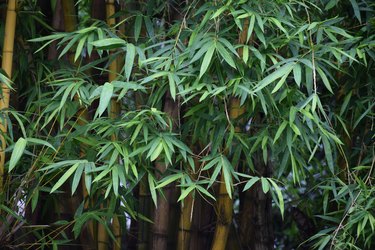
Bamboo is one of the hardiest plants on Earth. In fact, you can get varietals of bamboo to grow in all but the coldest parts of the United States. It will also grow in almost all kinds of soil, including sandy soil. This hardiness is thanks to its short root system. If you want to grow your bamboo in soil, you'll need to know how to plant bamboo in the sand and how to take care of bamboo, along with more information about this beautiful and useful plant.
How to Grow Bamboo
Video of the Day
While bamboo will tolerate and thrive in most soil types, it prefers loamy soil, which is a combination of sand, silt and clay. However, because it is such a hardy plant, plain sand is fine.
Video of the Day
Does bamboo need sun? Yes, it needs full sun. Even though bamboo is terrific for creating privacy and shade, it needs as much sunlight as you can give it, so you need to choose a sunny spot.
To plant your bamboo, dig a hole twice the width with an equal depth as the container your bamboo is in now. Put your bamboo plant inside the hole and fill the sandy soil around it. Cover the area with mulch, pack it on top of the bamboo roots and then water to saturate the ground after you're finished planting. Spread mulch everywhere you want the bamboo to spread but keep an eye on your bamboo to prevent it from choking your other plants. Be aware that this plant is considered an aggressive spreader and is even considered an invasive species in some areas.
How to Take Care of Bamboo
Since it's so hardy, you might not be surprised to learn that bamboo doesn't need much time and attention. Still, knowing the basics of taking care of a bamboo plant will ensure it thrives.
If you're wondering how often to water bamboo, your plant will make that clear to you. Most experts recommend thoroughly watering twice a week or three times if it's particularly hot. If you see the leaves starting to curl, your plant is too dry. It should bounce back with a couple of soakings, though. If you live in an arid climate, you will want to try to plant green onion bamboo, which absorbs water quickly from the fast-drying ground.
Unless your bamboo spreads aggressively, you will want to fertilize this plant in the spring with a balanced, slow-release fertilizer, such as a 10-10-10 fertilizer. The mulch will provide all the fertilizer your bamboo needs in the first year.
Fun Facts About Bamboo
There are more than 1,500 types of bamboo plants, but most of them fall into one of two categories: clumping and running bamboo. Clumping bamboo won't spread as quickly. Bamboo is a type of grass instead of a tree or other type of plant. Although commonly associated with Asia, it is native to every continent, with Europe and Antarctica being the exceptions.
Bamboo roots and rhizomes are very shallow, which is one of the reasons it can thrive in virtually any type of soil. As long as it gets regular moisture, water doesn't have to saturate the ground to reach bamboo roots.
Bamboo plants typically live seven to 10 years in the right conditions. Even though individual culms die after about a decade, you (and your descendants) can maintain bamboo forests for hundreds of years. Bamboo plants can also be transplanted, and they reproduce without much encouragement.